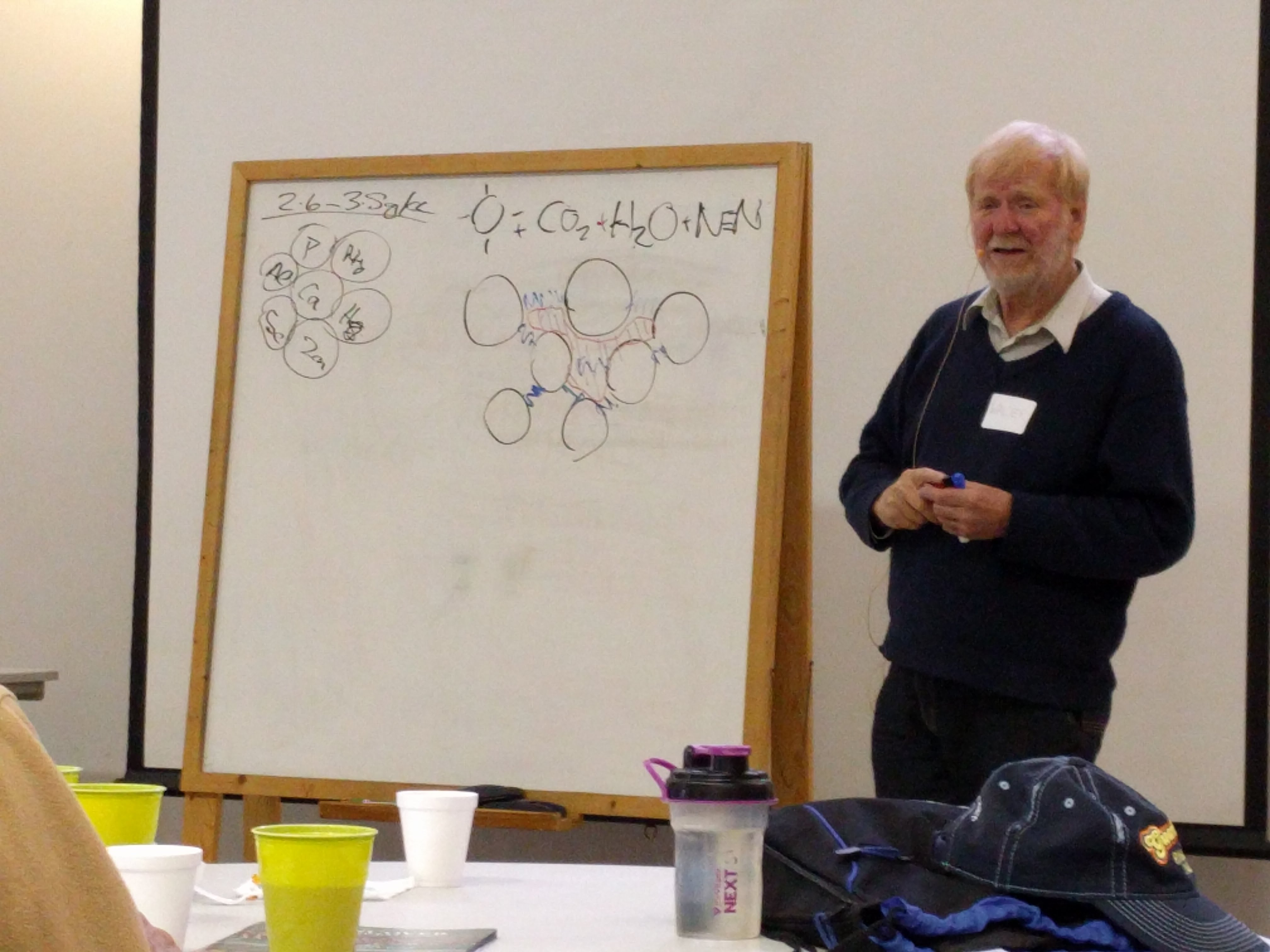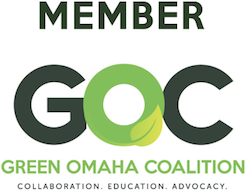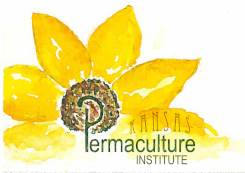By Ben Stallings |
Opening remarks: Gail Fuller
- When speakers from past years start returning to learn, that tells you about the quality of the speakers and also their modesty!
- Jonathan Lundgren is caught in a blizzard and may not be here this year.
- This conference is not so much about increasing yields or profitability. It’s about doing what’s right.
Soil is Life: Gail Fuller
- Farming is all about rolling with the unexpected situations that nature throws at you.
- A properly functioning water cycle will eliminate food deserts, restore ecosystem function, stabilize governments. Not about increasing yields.
- Ted Alexander’s ranch in Sun City, KS: semi-arid, red cedar. Reestablished intermittent stream. Lost 7000 acres and all his fence in the fire two years ago, but eliminated all the cedar and gained two more streams.
- Unhealthy water cycle looks like record-setting wldfires every year, in the same part of the country where the dust bowl happened. Not due to farming practices this time, but ranching. Wildfires are caused by mismanagement.
- Colin Zeiss ranch in Australia survived a wildfire in 114 degree heat. Fire came onto property and burned out.
- Today’s production model (since WWII) focuses only on yield. Boom of the ‘70s led to farm crisis of the ‘80s. Still being told to increase yield. It’s not about feeding the world; we already produce more than enough food.
- Some permaculture gardens are producing 7000 pounds of food organically per year on 1/10 acre.
- Soil degradation means we will produce 30% less food over the next 20-50 years.
- Farmers and researchers see weeds as the problem, but mother nature sees bare soil as the problem and weeds as the solution.
- Success without integrity is failure. Current model is turning farmers against each other - conventional vs. organic, neighbor against neighbor. But farmers drive the economy.
- Why are we wasting our money on fertilizer when legumes can produce it for free?
- Insects are crucial to agriculture, but most farmers focus on eliminating insects, so that the ecosystem collapses. Nearly half of mammal species lost 80% of their distribution between 1900-2015. ¾ of flying insects in Germany have disappeared. For every pest insect species, there are 1700 species that are helpful or have unknown impact on crops.
- Sugarcane aphids affect sorghum crop, but spraying kills the predators too. Aphids release sugar that gums up machinery, but honeybees will harvest the sugar and restore harvestability.
- Every ecosystem on the farm is dependent on every species except us.
- Kansas water cycle: Ogallala Aquifer is responsible for 20% of corn, wheat, cattle, cotton. 70% the size of Lake Erie. Currently 30% depleted, projected to 69% depleted by 2100. Annually 6 miles of streams and rivers go dry due to depletion.
- John Redmond Reservoir in Burlington has 6’ average depth, had to be dredged for $20M to remove sediment equivalent to 1 year’s erosion. No plan in place to slow sedimentation.
- Nitrate removal systems on water supplies cause costs to increase 40x or more. Cities are not going to stand for it. Farmers can reduce nitrogen themselves or wait for government to require it.
- Soil is our #1 resource, but our #1 export (to the ocean). Soybean is the #1 crop in eastern KS, wheat in the west. Losing 3.5 pounds of soil per pound of wheat, 4.5 pounds per pound of soy.
- We are told we’re growing commodities, but we grow food, and food should be medicine. Instead we’re producing nutritionally deficient poison, creating health crises. Have to fix the water cycle to get nutrition back into the plants and restore our health.
- Soil microbiome and gut microbiome are virtually the same. If we’re destroying the soil microbiome through farming practices, we’re doing the same to our guts.
- Cancer industry now employs more people than have ever died of it. 17% of GDP. Do we really want to cure it? Cancer deaths are going down but incidence is going up. 1 in 2 Americans will have cancer in their lifetime.
- Farmers drive society and need to lead it. Fuller Farms will have monitoring sensors for water quality, infiltration, photosynthesis.
- Ultimately, farmers need to be paid for environmental services they provide.
Judith Schwartz
- Longtime freelance writer, on a broad range of topics.
- It’s not just that we have believed the experts too long; they have been telling us to believe us, and we have gone along with it without questioning. The lack of curiosity among journalists is disgraceful.
- Questions to explore: what is water infrastructure? How does the earth regulate heat? How might land management affect weather?
- When we think of water infrastructure we tend to think of big projects like huge dams or the LA River. But beaver dams are crucially important. A healthy water cycle is slow, not fast.
- Restoring the water cycle can restore biodiversity (and vice versa), but because many species are migratory it can’t just be a local effort.
- Soil is water infrastructure. Without plant cover, it seals over and may as well be concrete. Microscopic soil aggregates are even a form of water infrastructure.
- The amount of water we’re fighting over (in dams, water supplies, etc.) is only about 2% of the total. 80%+ is in the soil (or could be).
- How does the earth regulate heat? Climate movement has done a disservice by focusing only on CO2 levels when more than 90% of climate is driven by water based processes, and water is dominant greenhouse gas. Water is more effective at transferring heat than any other substance.
- “The Future Climate of Amazonia” by Antonio Donato Nobre: trees are like geysers, spraying a river of vapor into the air, 5x as much as the Amazon river itself. The cooling capacity of a single mature tree is greater than the AC of a 5-star hotel.
- Condensation releases heat, completing the cycle, so the water cycle redistributes heat.
- Plants are running the show. We need more photosynthesis.
Walter Jehne
- Soil microbiologist, climate scientist, permaculturalist from Australia.
- Start 4.6 billion years ago with a supernova that created our solar system. 96 natural elements in the periodic table.
- 4.2 billion years ago the Earth had liquid water, very quickly ocean life.
- Ocean life was limited by nutrients leaching from the land. Fungi worked with algae to colonize the land and solubilize new nutrients.
- Death of lichens on land created the first organic soils (petogenesis). Organic matter held water and increased productivity: mosses, ferns, etc.
- Grasses evolved along with herbivores - require herbivores to complete their life cycle.
- Plants combine what nature has in greatest abundance -- sunlight, CO2, H20, N2, and make sugars. But need nutrients, which they get from microorganisms, which live in soils.
- How does nature create healthy soils? Make a sponge out of carbon from sugars, to hold the nutrients. The voids between particles are crucially important for holding air and water, as well as habitat for the microbes and rootability for plants.
- Healthy soil has 10x the biomass of microbes below ground as of animals above ground.
- The real take-home benefit of regenerative agriculture is not peak yield but resilience. Agribusiness is hoping for a 30% improvement in productivity, but we can produce 100x by focusing on soil microbes.
- It’s not CO2 that matters, it’s the biological system. It’s all down to farmers.
- Charles Keeling in 1958 showed that CO2 was increasing in the atmosphere by about 10G tons per year. Nature draws down about 120G tons/year, but we add 130G tons. The drawdown is accomplished by only about 60% of the vegetation that we started with. Regeneration would mean not just reducing emissions but restoring the vegetation.
- Every year we burn forests and grasslands and don’t account for it because it’s nature’s problem.
- How to get carbon back into soils: plants keep about 30% of carbon above ground, 30% in the root system (prairie grasses are more like 25%/50%), remainder leaks out as root exudates, which feed the ecology of the soil. 25Mm of hyphae per m^2 of healthy soil.
- When hyphae die back, chitin degrades into glomalin, which holds the soil together. Bacteria make humates; together humates and glomalin are stable soil carbon.
- Three destinations for photosynthesized carbon: A)gricultural yield, B)urning/respiration, or soil C)arbon. If we maximize A at the expense of C, that’s unsustainable.
- But if you have C, you generate D)ividends: every gram of carbon holds up to 8 grams of water, plus nutrients and resilience.
- Herbivores are mobile biodigesters. They take the yield A, prevent it from burning B, and put it into carbon C, producing dividends D along the way. They do require water. Need to restore the in-soil reservoir so you can get your water from ponds and not from dams.
- Before Davy Crockett, there were 400 million beavers in North America, all building new dams every few years.
- Transpiration takes 590 calories of energy per gram, cooling the surface. Most of that heat gets radiated into space when the water condenses in the atmosphere. Additionally, cloud cover can reflect light due to its albedo. But this all depends on the soil sponge.
- It takes about a million cloud condensation nuclei to make a raindrop. Nucleation happens around ice crystals, salts (esp. Silver iodide), or certain bacteria.
- Glyphosate is a chelating agent, and is popularly used to desiccate crops before harvest. Greatest harm is water pollution after use, disrupting the microbial life in soil and our guts.
- Condensation creates low air pressure, so a rainy area like the Amazon basin has air continually moving in from the ocean. Desertification creates a high pressure heat dome so that the moist air no longer flows in.
- Sequoia trees get 70% of their moisture from condensation, provided the moist air is flowing in.
- Hyphae selectively concentrate needed nutrients while selectively excluding toxins. Under natural conditions, 99%+ of all plant nutrients pass through this selective hyphal membrane.
- After WWII we transitioned from the natural nutrient system to industrial hydroponics. By providing nutrients in solution, we cut out the solubilizing processes out that had provided quality control. The plant just takes up whatever nutrients are soluble, even if toxic. We have fundamentally undermined the nutritional integrity of our food supply by eliminating the quality control.
- If we don’t address the microbial deficit behind our nutritional deficit behind our health crises, we will not be able to survive the health crises.
- How do you measure soil microbial health? Bioassay: look at level of infectivity on a bait plant and compare to level in different conditions.
- Green Revolution was mostly development of dwarf plants, reducing stem development.
- What you see as a mushroom is maybe 1% of the fungal biomass.
Manipulating Science for Corporate Profits: Jonathan Lundgren
- Ecdysis Foundation and Blue Dasher Farm are in South Dakota, two years now.
- Crises facing the planet: climate change, pollution, human health, civil unrest, declines in biodiversity; all related to the central problem of how we’re producing food. Agriculture has become far too simplified.
- Regenerative farming isn’t mainstream because paradigm shifts take time, and because science has been misdirected. It’s not always easy being a scientist - historically martyred, and truth only becomes evident after their deaths.
- Science provides understanding, not truth. Especially biology! There is no such thing as a perfect scientific study.
- Tobacco industry revolutionized the art of obscuring science: obscure inconvenient studies; fund a preponderance of supportive evidence; discredit and intimidate inconvenient scientists. This now happens every day in every laboratory.
- There is a “crushing” amount of evidence that pesticides, and specifically neonicotinoids, are the significant contributors to bee declines. But industry-funded evidence points to the varroa mite. Bee colony collapse has never been a bee problem, it’s an agriculture problem.
- Science is not sufficient to solve problems. Data does not change behavior.
- Lungren worked for the USDA for 11 years, did everything right. Met Gail Fuller and Gabe Brown at No Till on the Plains, turned research to validating what they were doing. Met beekeepers and learned that the lab that was testing bees for insecticide residue was corrupted.
- Started to do research that neonics don’t help farmers and kill beneficial species. Previously approved publication got retracted.
- Started to research RNAi-based pesticides as a risk to non-target species. RNAi is banned by the UN but not recognized as GMO in the US. Got told to go through the Secretary of Ag before speaking or writing.
- Started to say over-reliance on corn agriculture is a national security threat. USDA removed his name from the peer-reviewed paper. Got harrassed every day for routine approvals; media interactions had to be approved in every detail; suspended without pay; then direct suppression of research.
- The people in the chain of command weren’t bad people, they were just terrified of losing their funding.
- Whistleblowing is not necessarily a heroic gesture. That decision hurts everyone in your life.
- Quit noisily, bought Blue Dasher Farm to promote regenerative agriculture. Goals: research to remove barriers for regenerative farmers; train scientists nad farmers in regenerative principles; demonstrate those principles. Research with no strings attached, thanks to crowd funding initially announced here at Field School.
- Now have a world-class facility and a community to support it. Training students to be systems thinkers with a focus on problem solving.
- Farming not only their own acres but also other neighboring farms. Never till, prioritize diversity, but growing high-value seed for cover crops and conservation mixes. Produce honey that’s 100% honey, not flavored sugar. US is now losing 150% of bee hives every year (requeening multiple times a year). Poultry for eggs & meat, hair sheep; planning pastured pork.
- Why do the right thing? Because we feel compelled.
- What pisses him off about Dicamba is that everyone’s passing the buck: farmers say university scientists never told them; scientists say it’s Monsanto’s fault; Monsanto blames USDA. Everybody is to blame, but killings in Arkansas are just a symptom of a broken system.
- Land-grant universities have lost their sense of mission. The promise was that federal funding would support free research, but universities became too top-heavy and needed funding for bureaucracy so that scientists have to compete for money and become dependent on corporate funding. Half of every grant goes to the bureaucracy, not the research.
- Last year KU entomology students invited Lundgren, and farmers showed up unexpectedly, and afterward everyone went to dinner except the professors, and students begged for positions at Ecdysis so they wouldn’t have to go to Monsanto or Syngenta.
- RNAi pesticides are not specific to pest species -- every target has a match in the honeybee genome. Nobody has yet checked it against the human genome, but the product is already commercialized.
- Regenerative corn production: lots of variation in regenerative practices, but none of the regenerative farms were using pesticides and all the conventional farms were. Found that conventional farms had 10x more pests. Regenerative farms had 22% lower yield but were twice as profitable -- profitability directly correlated to particulate organic matter in the soil.
- Now working on finding bioindicators of soil health, and insects fit the bill really well.
Notes on field session: Gail Fuller
- Native prairie had many more cool-season grasses and forbs than contemporary pasture. We have burned them out in favor of C4 grasses. That is not a complete ecosystem and is not sustainable.
- Current production goal is just to grow enough to feed pigs and chickens. There is demand for feed, but they don’t have a surplus yet.
Judith Schwartz again
- Human systems are more negotiable & malleable than natural systems, but we tend to look at economic “laws” as inviolable like natural laws.
- People can use and manage products that are totally legal, in the correct way as directed, and contribute to the destruction of the environment, because we’ve created a system that makes that OK. But we can change the system to incentivize constructive behavior instead.
- Raj Patel: “Many people can more easily envision the end of the world than the end of capitalism.”
- We talk about employment as if jobs are the only way to contribute to the economy, instead of asking what needs to be done and focusing on the opportunities.
- We celebrate every acceleration of the economy as if it’s not directly killing the environment and society. Everything that’s bad for people and the environment is good for the economy.
- If we’re not getting useful feedback from our economic system, that’s a design flaw.
- Slow Money movement is looking at other forms of wealth outside the conventional economy.
- Industrial fertilizer is a transfer of the soil capital to the current account.
- “We know of no bank that could, with all of its wealth, have a litter of pigs produce an egg or a calf.” (i.e. the various forms of wealth are not interchangeable.)
- John Liu on the Loess Plateau: we now know we can restore large-scale ecosystems. Since we know that, we are obliged to do so.
- Discussion: if making money were not a requirement, what would you do? Analogous to the water cycle -- having a healthy economy and stable income would be like having a healthy water cycle and not having to worry about precipitation.
- If everyone in KS spent $5 a week on local food, we’d have $750M in additional state revenue. Every dollar retained locally generates another $5 in local activity.
- Wealth inequality destroys quality of life because of communicable diseases, so one impact of basic income would be improved public health and quality of life.
Final Q&A
- 100th meridian has historically been the dividing line between arid & humid environments in the US, but it has moved 150 miles east, now at the border of the Flint Hills.
- Microclimates can’t affect rainfall, but they can harvest dew from humidity.
- Vimeo.com search for kcsaac to find field school videos.
- Corn crop in western KS is already in the red due to late planting, meanwhile millions of cows in OK are homeless due to fires. Opportunity to plant cover crops instead of corn and save the herds at a profit.
- There is no Monsanto anymore; all we have left in the US now is the liabilities of Monsanto; all the assets are now owned by Bayer, in Germany. They knew the lynch mob was coming, and now there’s no one to hang.
- Two sets of customers for G&L Whole Foods: those who don’t care what it costs, and those who do care but prioritize food quality. Those who don’t prioritize food quality are not customers, for better or worse.
- Regenerative farmers need a 30-second “elevator story” to sell what they do.
Permaculture session: Walter Jehne
- “You can’t be green if you’re in the red.” How do we get back to the value chain where farms are profitable?
- As a society we’re investing in food processing and disease treatment, not food quality.
- Jehne was at University of Tasmania at the same time as Bill Mollison. Now time to use those principles to design a 21st century agriculture.
- Experiment of Cuba demonstrated that permaculture principles can help a struggling society gain resilience with limited resources.
- First step in design is always to look at where we are now, in reality, and what issues we have to address. Climate, water, nutrients, ecosystem.
- Second step: where do we want to go?
- Third step: options to get there. ¾ of the time it means doing less. Don’t do the destructive things we’ve been doing, let nature breathe.
- Fourth: What are the critical success factors? What is the critical path through the hazards?
- Fifth: What are the desired outcomes? Regeneration and revitalization of the land, farm, and community.
- Any system is a normal curve - a small number of people are ahead of the curve (e.g. of innovation), while most are in the massive status quo. Those who are slightly ahead of the SQ are the gatekeepers: scientists, universities, etc. Some gatekeepers impede progress while others are trying to move it along. “Barricades are red with the blood of people who have fought the gatekeepers.” We need to go way past them and plant a flag on the hill. Demonstrate we can get the same yields with less inputs.
- Soil carbon sponge: nature’s design solution to make soil nutrients available to life. The voids between particles hold water and air.
- Permaculture approach to weeds: create soil conditions where weed can no longer outcompete the desired plants. Every plant by growing changes the microhabitat; most weeds change the habitat to exclude themselves. Same is true of insects and other pests. If you can’t beat them, eat them.
- Weeds with their deep roots have had an advantage in harvesting nutrients; herbivores can harness that nutrition and release it for the other plants.
- Prickly pear has been an invasive weed in Australia, making many acres impassable. Attempts at control just created more habitat for prickly pear to regrow. Imported a moth from the native ecosystem in South America that reduced 99.9% of the prickly pear in one year.
- Suggestion for red cedar - what are the ecological factors farther east that kept it in control, what are the conditions that have given it a competitive edge? How do we manage fire intelligently?
- By midcentury we are predicted to have 10 billion Homo hubris on the planet.
- Plant willows in wetland, coppice and feed to sheep, who redistribute nutrients throughout the field.
- Biodome: shipping container with a plastic canopy to control temperatures, effluent comes in one end, aquatic plants and microbes harvest the nutrients, harvest every 8 days and use for stock feed, cleaned water comes out the other end. Condenser on canopy harvests potable water - don’t drink it directly; remineralize it first, but still, potable water. When sludge builds up, feed it to worms, feed worms to fish or chickens or pigs. There’s potential for profit and employment every step of the way.
- Regulations in Kansas don’t allow growing cattails in sewage lagoons. Don’t charge the barricades, demonstrate a better way.
- Nature puts in woodlands on slopes and shelterbelts and other inaccessible places, with higher productivity than in open areas. Understory plants are medicine to browsing herbivores, who will seek out the plants they need for health.
- Horses and donkeys have a very short digestive tract. “Don’t wait for something to pass through a camel - you won’t even get the iron fence post back!” But you can coat seeds in wax to pass them through a horse or donkey and allow them to plant shelterbelts for you.
- Work beyond your fenceline. If you don’t have enough acreage to keep large herbivores, share with your neighbors.
- Urban agriculture: 70% of the people are in urban areas, and most of our youth. We are crowding out the capacity of our youth to have a future on the land. It’s a design opportunity.
- Wicking bed: Go to a junkyard and get a pallet. Make a box. Wrap bottom 10cm in plastic so it can hold water, set plant pots in the gaps between slats. Then another plastic sheet, then compost and clay subsoil, then mulch. Water should wick up into the soil. Build the whole thing for a couple dollars and put it anywhere kids need to learn about gardening without interacting with the soil below.
- If you’re gardening anywhere near trees, your vegetables are not getting most of the nutrients and water because mycorrhizae are taking those for the trees.
- Around the world, 80% of the food is grown by women, even though women don’t own most of the land. So they’re sharecropping in inequitable situations. But a wicking bed is above the ground so doesn’t belong to the landlord.
- After soil has been used a few years in the wicking bed, use it to build a swale and plant fruit trees.
- Industrial food system has disempowered everyone from the producer to consumer. Undoing that means building market relationships - joint venture niches. Farmers join together into supply syndicates with a critical mass / scale to supply consistent volume & reduce costs of operation.
- Meeting the needs of consumers such as restaurants means transforming the products (“adding value”). But we can do this locally and with ownership by the supply syndicate / farmers.
- But only about 50% of each animal is meat; the other 50% is often wasted. But the waste can be ground up and fed to maggots, which are fed to chickens or pigs, but ideally tuna. As with the biodome, there’s potential for profit and employment at every step.
- Grain syndicates have turned low-profit grain into high-profit specialty products such as protein powders. But the demand for high-quality processed products is what creates niches for processing.
- Criticism of co-ops: democratic / representative decision making enforces the status quo. Supply syndicates can be started on one person’s initiative without the inertia of group decision making.
- Log in to post comments





